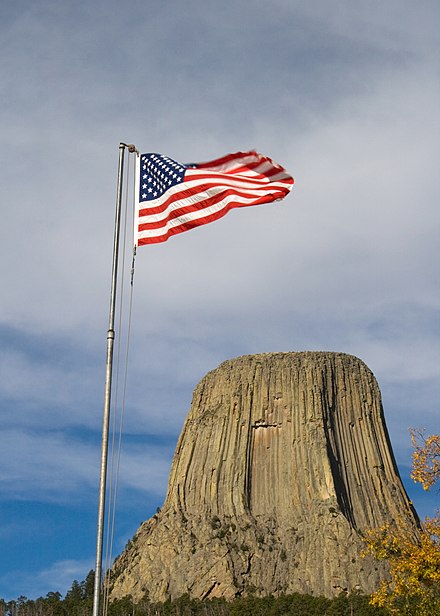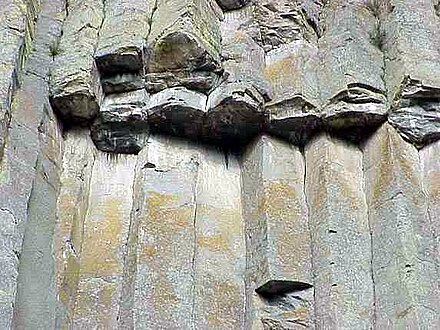Devils Tower National Monument - National Monument near Moorcroft, Wyoming, United States
Devils Tower National Monument (Mato Tipila in Lakota) is a national monument in Crook County, Northeast Wyoming. The monument is the core of an ancient volcano; the surrounding softer rock has over time been eroded to reveal cooled magma hardened into igneous rock, appearing as fluted shafts and columns rising over 500 feet (150 m) in the air. The monolithic tower rises above the Belle Fourche River at the edge of the Black Hills region, known in this section as the Bear Lodge Mountains. The monument was established as the first national monument by President Theodore Roosevelt in 1906.
 This landmark is traditionally sacred to several Native American tribes including Lakota, Arapaho, Shoshone, Cheyenne, and Crow tribes. It is managed as a U.S. National Park and is open to the public, but travel here for non-Indigenous tourists requires awareness and respect for these sacred grounds.
This landmark is traditionally sacred to several Native American tribes including Lakota, Arapaho, Shoshone, Cheyenne, and Crow tribes. It is managed as a U.S. National Park and is open to the public, but travel here for non-Indigenous tourists requires awareness and respect for these sacred grounds.
Understand
History
Devils Tower was known as "Mateo Tipi" by Native Americans of the region, and is considered sacred. "Mateo Tipi" translates as "Bear Lodge", as the Indian legend revolves around the creation of the tower as a refuge for a group of Indian youths being pursued by a giant bear. Imploring the great spirit to save them, a rock they were standing on began to rise into the air. The bear tried to reach them, with its claws carving the fluted columns into the rock. The youths then were taken up and became what is known as the seven sisters constellation. A U.S. cavalry scouting party reached the tower in 1876 and incorrectly translated the name to mean "Bad God's Tower", and thus its present name remains.
Devils Tower is a popular place for rock climbing, hiking, and as a tourist waypoint between popular destinations such as Mount Rushmore National Memorial, Badlands National Park, Yellowstone National Park and Grand Teton National Park.
It is probably best known as the location of the alien-human rendezvous point in Steven Spielberg's 1977 science fiction film, Close Encounters of the Third Kind. Production designer Joe Alves traveled the west looking for a proper landmark and stumbled across the obscure park finding it a perfect fit for use in the film. Devils Tower National Monument is administered by the National Park Service, a part of the Department of Interior.
Landscape
The one obvious contrast in landscape here is jarringly weird, and indeed the main attraction! Devils Tower is one of the world's most striking natural monoliths in no small part for its sheer, vertical form, and its dramatic contrast with the rolling prairie extending in all directions for seemingly endless distances (the rolling prairie being essentially a lower extension of the nearby Black Hills in South Dakota).
The tower is the eroded remnant of a giant laccolith—an igneous intrusion produced by rising molten magma exploiting a weak point in the existing sedimentary rock layers about 65 million years ago. Over the epochs since, the softer sandstones and shales that covered and surrounded the intrusion (which had pushed them up), leaving us with this alien-attracting, arrestive tower. The tower is made of constantly-eroding polygonal columns of phonolite lava (similar to the columnar basalt found at the Giant's Causeway in Northern Ireland, as well as at Devils Postpile National Monument in California).

You might notice that the forest rolling along the hills is a little repetitive. The lack of diversity was caused by fire suppression by ranchers, settlers, and by the U.S. Forest and Park Services, as a means of avoiding fires spreading to settled areas and the burning down of the valuable and beautiful forests. But without the natural cycle renewal caused by (natural) forest fires, the Ponderosa pine has taken over, depriving any smaller ground plants from getting needed sunlight. The Park Service has been undertaking prescribed burns to try and restore the rich, diverse ecosystem that once prevailed.
Flora and fauna
Prairie falcons nest on the monument, and some climbing trails are closed yearly to protect the nestlings. Annual information about closings is available on the National Park Service web site.
The meadows on the approach roads to the tower are the home to colonies of Prairie Dogs. Do not approach them because of the risk of contracting rabies if bitten.
Climate
Get in
By air
The nearest airport with commercial service is the Gillette-Campbell County Airport (IATA: GCC) in Gillette, with commuter service to Salt Lake City and Denver Airport. The closest full-service airport is Rapid City Regional Airport (IATA: RAP), across the border in South Dakota and served by five airlines. US Route 14 links the two cities.
By car
Devils Tower National Monument is located off Wyoming State Route 24, which is accessed via US Route 14. The US-14/WY-24 intersection is about 1 hour east of Gillette and 1 hour and 30 minutes west of Rapid City.
Fees and permits
Entrances fees are valid for seven days, allowing unlimited re-entry for the week. Fees as of 2020 are:
- $15 - Individual on foot/bike
- $20 - Motorcycle
- $25 - Private vehicle
- $45 - Devils Tower National Monument Annual Pass
Get around
Most visitors enter the park by car or bus from the east, to take a two-mile or so drive to the base of the tower on its northwest side. There they find a visitor center with background on the park and interesting books and souvenirs. Nearby, they will find modern restrooms. From the visitor center, they can choose to walk the full perimeter of the tower at its base on a path approximately 1.3 miles (2 km) long. In primary tourists season, the more adventuresome can apply for permission to climb the tower after showing adequate preparation and qualification.
See
Now, there is one colossally, hulkingly obvious attraction here. But there's a little more to see beyond the gaping-mouthed stare the tower evokes. Hikes described below will take you to the Belle Fourche River, through some pretty prairie landscapes, and past the occasional Japanese-crafted abstract peace statue.
- Devils Tower National Monument Visitor Center, 44.5903°, -104.7207°. The Devils Tower National Monument Visitor Center has interpretive exhibits, and the Devils Tower Natural History Association bookstore and souvenir shop. The visitor center was built in the 1930s by the Civilian Conservation Corps and is listed on the National Register of Historic Places. 2020-07-02
Do
There is a good amount of trail here for day hiking, with the Red Beds Trail being particularly rewarding. If you're not up for a long hike, try heading up the Red Beds Trail from WY-110 near the KOA campground, which will take you to a pretty section of the Belle Fourche River, where you can see some of the old, soft red sandstone that once covered the tower.
- Tower Trail Walk. Enjoy a walk around the base of one of the most unique geologic formations in the world! Learn about the natural and cultural history of Devils Tower National Monument, from theories about how it formed to the connections modern tribes maintain with the site today. 2020-07-02
Buy
In addition to offerings at the visitor center, you'll find a post office and trading post just outside the park entrance. The latter offers snacks and soft drinks plus another collection of souvenirs. Inside the visitor center you can find park staff, the Devils Tower Natural History Association Bookstore, and exhibits which teach the natural and cultural history of the park. The bookstore and gift shop sells artifacts, books, and souvenirs ranging in theme from nature, astronomy, science, Western U.S. culture, and Native American culture historical and current.
Eat
The nearest restaurants are in the tiny town of Hulett (fewer than 400 residents) to the north on WY-24 (about a 15-minute drive from the park's gate). Sundance would be a little larger (about 1,000 residents), and has a little notoriety to the name — the Sundance Kid gets his name from his stint in the town's prison in 1888 — but is a further drive, about 30 minutes southeast along WY-24 to US-14 E.
Drink
Sleep

Lodging
- Devils Tower Lodge, P.O. Box 66, #34 S.R. 110 (drive into the park and take the road to the Joyner Ridge Trail Head), 44.6017°, -104.7223°, +1-307-467-5267. A bed & breakfast that is in a former park superintendent's home on 21 acres. Amenities include queen beds, floor-to-ceiling windows, an open-air view deck, private baths, hearty breakfasts, outdoor spa and indoor rock climbing gym/exercise room.
Camping
- Belle Fourche River Campground, 44.5816°, -104.7066°. 46 sites, 3 group sites. All sites are first-come, first-served. The Belle Fourche River Campground is a 2-loop, 46-site campground with 4 accessible sites and 3 tent-only group sites. Drinking water is available at water spigots and in the restrooms, which have running water and flush toilets, but no showers. Large cottonwood trees provide shade. A picnic shelter and tables are available north of the campground. Due to wildfire precautions no campfires allowed, camp stove usage only. Well maintained with great views of Devils Tower. There is a 14-day limit on occupancy. There are 43 pull-through sites with room for RVs up to 35 feet. No hookups are available. $20 individual sites, $30 group sites (2020 rates) 2020-07-02
Backcountry
Respect
Native American tribal members who practice their traditional faiths make pilgrimages here to conduct personal and group ceremonies. Sweat lodges, sun dances, and other traditions are practiced at the monument. The most common ritual that takes place at the tower is prayer offerings. Colorful cloths or bundles are placed near the tower — commonly seen along the park's trails — and represent a personal connection to the site. They are similar to ceremonial objects from other religions, and may represent a person making an offering, a request, or simply a remembrance of a person or place. As with many religious ceremonies, they are a private to the individual or group. Do not touch, disturb or remove prayer cloths or other religious artifacts at the park.
Stay safe
Go next
Related: United States National Parks
Crook County
2nd-order administrative division
Wyoming
Primary administrative division
United States
usa.govPopulation:327.2 MDial code:+1Currency:Dollar (USD)Voltage:120 V, 240 V, 60 HzNEMA 14-30NEMA 14-50
